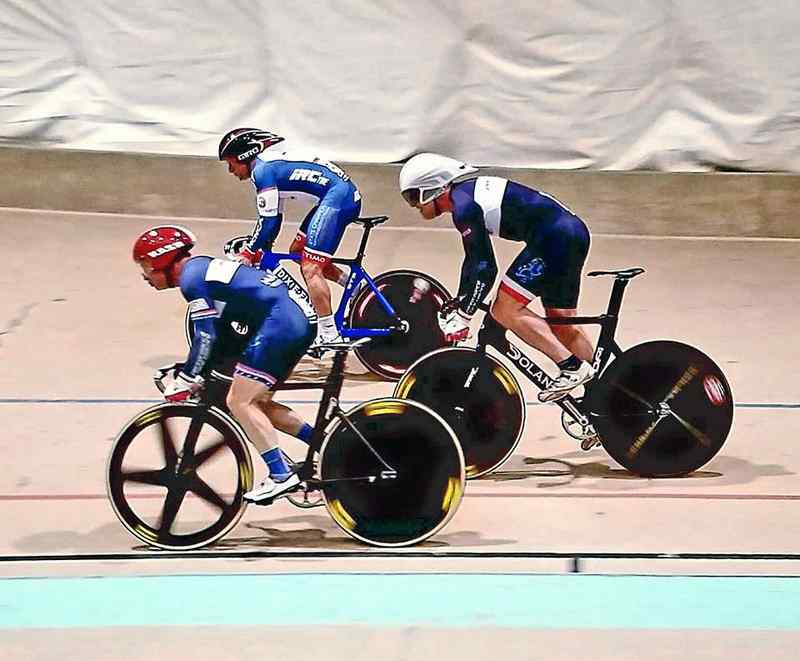
Santa Cruz’s Dennis Pedersen (center) races to the gold medal in the team sprint event with teammates Ray Gildea (left) and Brian Moore at the USA Cycling Masters Track National Championships in Colorado Springs, Colo., in November. (Beverly Chaney — Contributed)
As Dennis Pedersen crossed the finish line last month at the 2016 USA Cycling Masters Track Nationals, he didn’t know how he stacked up against the competition at the 7-11 Velodrome in Colorado Springs, Colo.
“I buried my head and focused on pedaling hard, legs and lungs burning, until I passed the finish line. At that point, I had no idea what our time was,” said Pedersen, 55, about his race on Nov. 20. “But as I cooled down, I heard on the PA that we had won my first national championship!”
His winning time? Just a little more than one minute. That’s how long it took for Pedersen’s explosive three-lap sprint, finishing in 1 minute, 7.477 seconds.
The Santa Cruz cyclist, a member of the Spokesman bicycle team, was part of a three-man team along with Raymond Gildea of Emerald Hills and Brian Moore of Merced. The trio competed in the age 55+ category and won the team sprint, which allocates the final time based only on the time of the third rider; the other two are not timed.
“Track cycling is a niche within a niche,” explained Pedersen. “There aren’t that many tracks in the country. There are about 12 active ones (including in San Jose). Most people only see it in the Olympics.”
Although bicycle track riding got its start around 1850, and has been included in nearly every modern Olympic Games (except 1912), it remains a mystery to many. Boiled down, it’s a bicycle racing sport typically held on specially built, oval-shaped banked tracks. Also called velodromes, these tracks are made of wood or concrete and range from a quarter to a third of a kilometer. Riders use track bikes with no brakes, one gear and disc wheels for the ultimate aerodynamic design.
As if having no bike brakes was not exciting enough, the “banked tracks” can be up to 45 degrees, such as the one at the L.A. velodrome, where Pedersen plans to compete at the 2017 UCI Masters World Championships.
“You have to experience it to believe it. You can’t walk up a 45-degree banking or you will slide down. The first time it was an incredible rush to ride. You drop down to the sprinter’s lane at inside of the track. It is intimidating. In L.A., you have to go through a certification before you ride. You feel like you are going to fall down off a three-story building.”
The discipline of track racing can generally be split into sprint events and endurance events. Sprint events require short explosive efforts, and are often very tactical, requiring a heavy focus on positioning. They tend to be contested by larger, muscular riders. Endurance events are longer and require sustained hard efforts.
“It’s all about your physiology,” said Pedersen, whose powerful leg muscles launch him at maximum speed, because the start of the race is critical.
“I’m better at sprinting. Some are born better at endurance and some as sprinters. I do well with flat courses, and short distances.”
On the big race day, at the 7-11 Velodrome, which is the official training venue for U.S. Olympic track cyclists, Pedersen’s three-man team lined up to start together, but they don’t finish together.
In an email, Pedersen explained how it works with his teammates.
“In team sprint, the three of us line up next to each other on the start line for a standing start. On the whistle we ride all-out, with Ray leading us out for one lap before he pulls off, his job done. Brian continues racing, with me following, for another lap before he, too, pulls off. I’m then alone, to finish the last lap and stop the timer. The blend of teamwork, timing and personal contribution is exhilarating!”
Ultimately, all of Pedersen’s hours of weight lifting, riding at the San Jose Hellyer Velodrome, motor pacing and following detailed workshops from his coach, Jeff Solt, paid off. Somehow he’s managed to squeeze his training around his full-time job as a web designer at West Marine.
It’s been a banner season for Pedersen, having also won three gold medals in track racing at the state level this summer. To cap it off with a national win is gratifying for him, though he’s quite modest about it.
“Now that I’m older, it’s less about the result and more about the process. I’m pleased and very satisfied. It’s a relief to see all the work come together. I never thought I’d be a national champion of anything and to be national champion at age 55 is pretty fun.”
Karen Kefauver (www.karenkefauver.com) is a freelance writer and avid cyclist who covers sports and travel and is based in Santa Cruz. Her Spin City bike column appears monthly and was launched in 2009.


